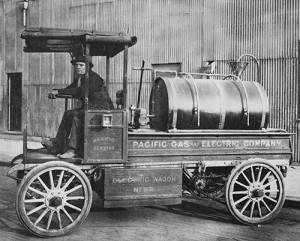There was no standard rate of pay for gas workers at San Francisco’s four gas companies in the early 1900s. Some companies had 12-hour work days. When competition between the companies drove down revenues, San Francisco Gas & Electric laid off several workers and piled that work onto those who remained.
San Francisco gas workers organized a union in the spring of 1902. It included gas “makers,” who manufactured gas from coal or oil, as well as the servicemen who maintained the distribution system. They threatened a strike unless the companies increased wages, reduced hours, and stopped adding to their workload. The companies granted wage increases of 10-20% and in some cases reduced the workload.
Utility workers wanted a uniform wage standard because they didn’t want their employers competing with each other based on who could drive down wages the farthest. Linemen led the way. IBEW locals on the West Coast formed the “Western Conference” to coordinate strategy.
In 1903, IBEW 151 and more than a dozen other locals joined a strike against PT&T that also included telephone operators in Fresno and Spokane. PT&T agreed to a company-wide minimum wage of $3 for journeymen, as well as the eight-hour day and time-and-a-half for overtime.
At IBEW’s 1905 International convention, delegates voted that all locals should join together in “district councils” like the Western Conference. Many inside wiremen as well as International officers were skeptical, but linemen saw these councils as a way to stand up to industrial-scale utilities. It was the beginning of an identity crisis for the IBEW.
